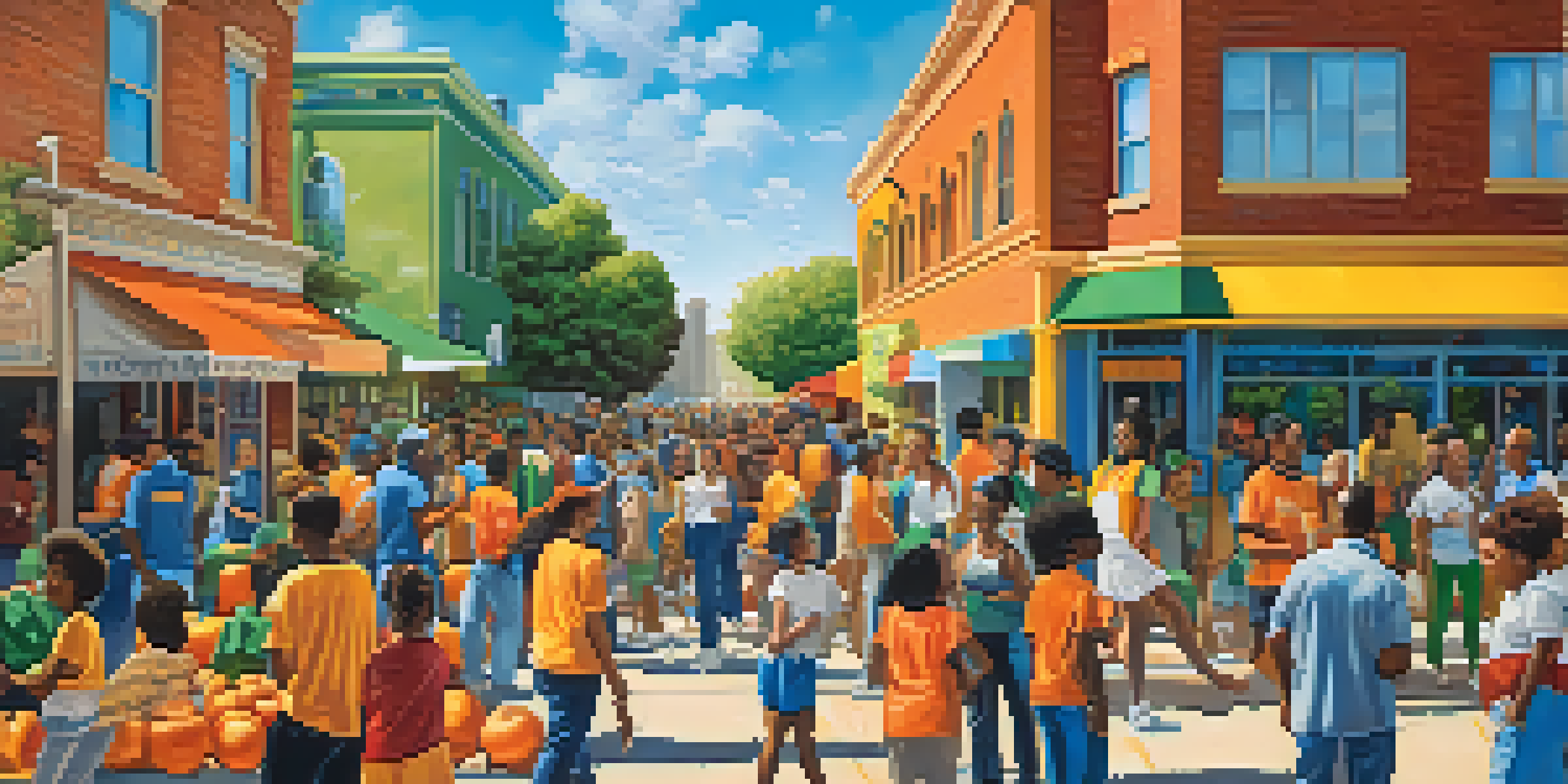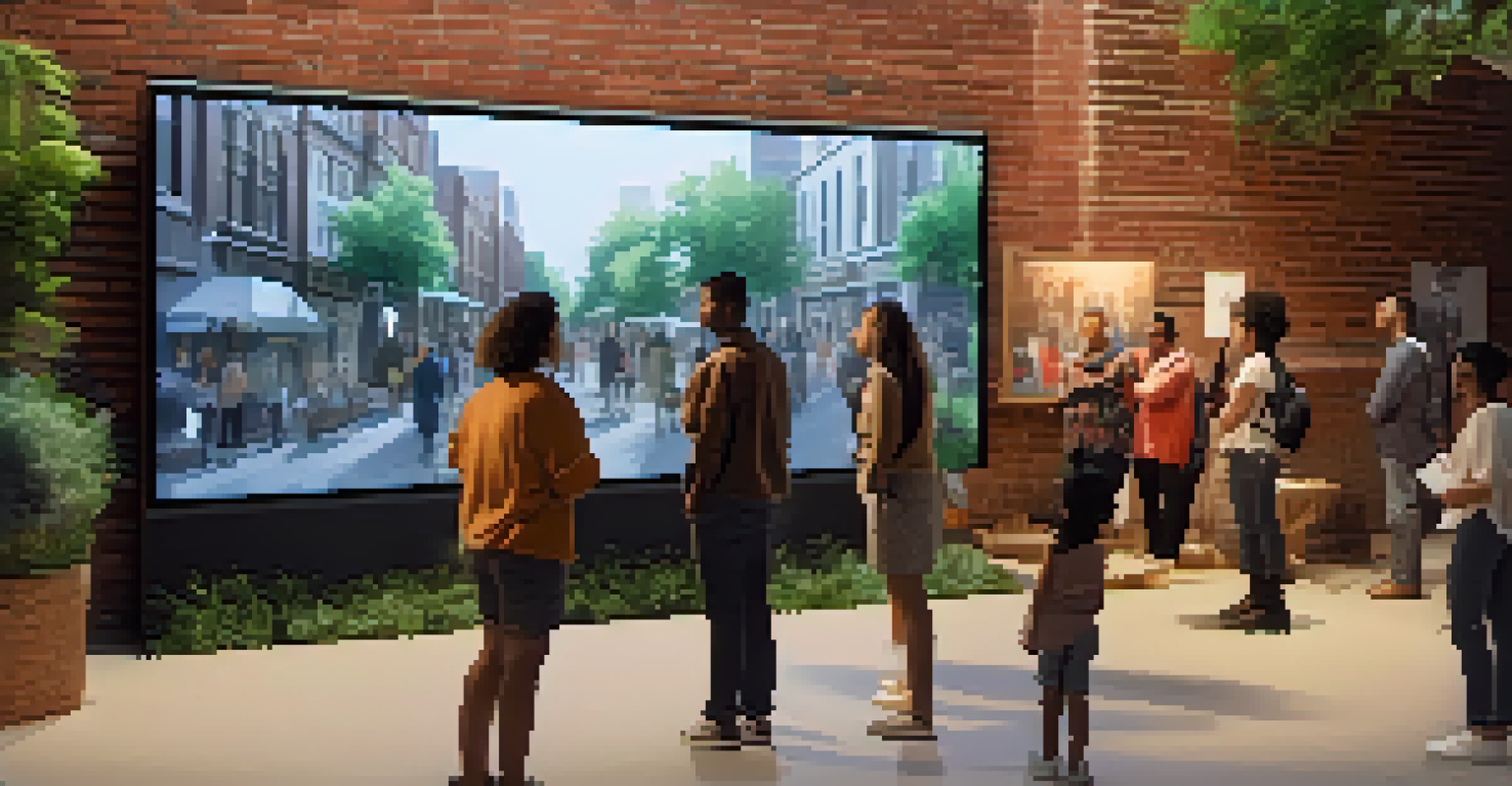Civic Engagement Through Art: Bridging Gaps in Communities

Understanding Civic Engagement and Its Importance
Civic engagement refers to the active participation of individuals in their community, fostering a sense of belonging and responsibility. It encompasses various activities like voting, volunteering, and participating in local events. Engaging with one another cultivates stronger communities and leads to collective problem-solving.
Art enables us to find ourselves and lose ourselves at the same time.
Art plays a significant role in civic engagement by providing a platform for individuals to express their thoughts and feelings about social issues. It encourages dialogue and reflection, allowing community members to connect on a deeper level. When people come together through art, they often find common ground despite their differences.
By understanding civic engagement and its impact, we can appreciate how art serves as a catalyst for meaningful conversations. It creates opportunities for collaboration and unity, ultimately leading to a more vibrant and inclusive community.
Art as a Tool for Community Dialogue
Art has the unique ability to spark conversations that might otherwise be difficult to initiate. Through visual art, performance, and other creative expressions, artists can address pressing social issues, inviting community members to engage in dialogue. This shared experience fosters understanding and empathy among diverse groups.

For instance, community murals can beautifully illustrate local stories and histories, prompting viewers to reflect on their own experiences. When people see themselves represented in art, they feel a sense of belonging and are more likely to participate in community discussions. This connection is vital for building trust and collaboration.
Civic Engagement Strengthens Communities
Active participation in community activities fosters belonging and collective problem-solving.
Moreover, art can serve as a bridge between different generations and cultures, creating a dialogue that transcends barriers. By sharing stories through artistic mediums, communities can work together to address challenges and celebrate their collective identity.
Case Studies: Successful Art-Based Engagement Projects
Several communities around the world have harnessed the power of art to foster civic engagement. For example, the 'StoryCorps' project in the United States encourages individuals to record and share their stories, creating a rich tapestry of community narratives. This project not only preserves history but also promotes empathy and understanding among participants.
Creativity takes courage.
Another inspiring example is the 'Public Art' initiative in various cities, where artists collaborate with local governments to create installations that reflect community values and concerns. These artworks often become focal points for community gatherings, discussions, and events, reinforcing civic pride and participation.
These case studies demonstrate the transformative potential of art in building engaged communities. By showcasing local voices and perspectives, art projects can empower individuals and groups to advocate for change, creating a more cohesive and vibrant society.
The Role of Local Artists in Civic Engagement
Local artists are often the heartbeat of community art projects, serving as facilitators of dialogue and creativity. Their unique perspectives and connections to the community allow them to understand the issues that matter most to residents. By collaborating with various groups, artists can create impactful works that resonate deeply with local audiences.
Moreover, local artists can inspire others to participate in civic activities by showcasing the importance of community involvement through their work. By embodying the spirit of civic engagement in their art, they encourage others to take action, whether through volunteering, attending local meetings, or supporting community initiatives.
Art Sparks Important Conversations
Art serves as a platform for dialogue, helping diverse groups connect and address social issues.
In this way, local artists not only contribute to the cultural fabric of their communities but also act as catalysts for change. Their ability to connect with individuals and provoke thought through art can lead to increased civic participation and a stronger sense of community.
Challenges in Civic Engagement Through Art
Despite the many benefits of using art for civic engagement, there are challenges that communities may face. One of the primary obstacles is securing funding for art projects, which can limit the scope and reach of initiatives. Without adequate financial support, many creative ideas remain unrealized, leaving potential connections unmade.
Additionally, not all community members may feel represented or included in art projects, leading to feelings of exclusion. It's essential for artists and organizers to actively seek input from diverse voices to ensure that all perspectives are acknowledged and celebrated. This inclusivity is vital for fostering a true sense of community ownership.
Addressing these challenges requires collaboration, innovation, and persistence. By working together and finding creative solutions, communities can overcome barriers and fully harness the potential of art to engage citizens and bridge gaps.
The Future of Civic Engagement Through Art
Looking ahead, the future of civic engagement through art is filled with potential. As technology continues to evolve, artists can leverage digital platforms to reach wider audiences and create more interactive experiences. Virtual reality installations, online workshops, and social media campaigns can engage individuals who may not typically participate in traditional civic activities.
Moreover, as communities increasingly prioritize inclusivity and representation, art can play a crucial role in highlighting underrepresented voices. By amplifying diverse perspectives, art can foster greater understanding and drive meaningful change within communities. This evolution of art as a tool for civic engagement will continue to shape the way we interact and collaborate.
Local Artists Drive Community Involvement
Local artists inspire civic participation by reflecting community values and encouraging engagement through their work.
Ultimately, embracing innovative approaches and harnessing the power of creativity will be essential for nurturing engaged communities. The interplay between art and civic engagement will evolve, ensuring that community voices remain at the forefront of societal change.
Getting Involved: How to Participate in Civic Art Projects
If you're inspired to get involved in civic engagement through art, there are numerous ways to start. One option is to seek out local art organizations or community centers that host workshops, exhibitions, or events focused on civic themes. Participating in these activities can help you connect with like-minded individuals and contribute to meaningful projects.
You can also volunteer your skills, whether you're an artist, organizer, or simply passionate about your community. Many art projects rely on volunteers for everything from planning and logistics to hands-on artistic contributions. By offering your time and talents, you can make a tangible impact in your community.

Finally, sharing your own stories and experiences through art can inspire others to engage as well. Whether through writing, painting, or performing, your unique perspective can contribute to the rich tapestry of community dialogue. Together, we can create a vibrant culture of civic engagement through art.